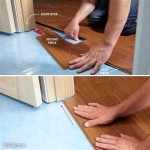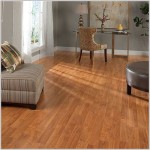Can You Glue Laminate Flooring Down? Examining the Feasibility and Implications
Laminate flooring is a popular choice for residential and commercial spaces due to its affordability, durability, and aesthetic versatility. The installation method typically involves a floating floor system, where the planks or tiles interlock and rest freely on an underlayment above the subfloor. However, the question of whether laminate flooring can be glued down arises frequently, particularly when considering specific installation scenarios or perceived performance improvements. This article explores the feasibility of gluing down laminate flooring, examines the potential benefits and drawbacks, and delves into the crucial considerations that must be addressed before undertaking such a project.
Understanding the Floating Floor System and Its Advantages
The floating floor system, the standard installation method for laminate flooring, offers several advantages. This method allows for expansion and contraction of the laminate planks in response to changes in temperature and humidity, which is crucial for preventing buckling or warping. Furthermore, the floating floor system simplifies the installation process, often requiring minimal subfloor preparation and enabling relatively quick completion. The underlayment, typically made of foam or cork, provides cushioning, sound insulation, and a moisture barrier, further enhancing the performance and longevity of the flooring.
The interlocking mechanism of laminate flooring planks is designed to create a strong and stable surface without the need for adhesives. This system allows the entire floor to move as a single unit, accommodating the natural movement of the subfloor beneath. Forcing the laminate to adhere rigidly to the subfloor negates this flexibility and can lead to significant problems in the long run.
The Argument for Gluing Laminate Flooring: Potential Benefits and Limitations
While the floating floor system is the industry standard, certain circumstances might lead one to consider gluing down laminate flooring. Proponents of this method often cite increased stability, particularly in high-traffic areas or commercial settings, as a primary benefit. Gluing down the laminate may reduce the "hollow" sound often associated with floating floors, providing a more solid and substantial feel underfoot. Additionally, in situations where the subfloor is uneven or has minor imperfections that cannot be adequately addressed with underlayment, gluing down the laminate might seem like a solution to create a more level surface.
However, these perceived benefits are often outweighed by significant drawbacks and limitations. Laminate flooring is not designed to be permanently adhered to the subfloor. The materials and construction of laminate planks are optimized for a floating installation, and gluing them down can negatively impact their performance and longevity. Furthermore, the adhesives required to effectively bond laminate to the subfloor can be costly and require specialized application techniques.
Critical Considerations Before Gluing Down Laminate Flooring
Before considering gluing down laminate flooring, several key factors must be thoroughly evaluated. Ignoring these considerations can result in costly repairs, premature floor failure, and voided warranties. These considerations cover subfloor preparation, type of adhesive, moisture condition and potential removal difficulties.
Subfloor Preparation and Compatibility
Proper subfloor preparation is paramount, regardless of the installation method. However, it becomes even more critical when considering gluing down laminate flooring. The subfloor must be perfectly level, clean, and free of any debris, dust, or contaminants that could interfere with the adhesive bond. Any imperfections or irregularities in the subfloor will be directly transferred to the laminate surface, resulting in an uneven and potentially unstable floor. Furthermore, the subfloor material must be compatible with the chosen adhesive. Different adhesives are designed for specific substrates, such as concrete, plywood, or OSB (Oriented Strand Board). Using an incompatible adhesive can lead to poor adhesion, adhesive failure, and ultimately, floor failure.
The moisture content of the subfloor is another critical factor. Excessive moisture can weaken the adhesive bond and cause the laminate to warp or delaminate. It is essential to test the subfloor for moisture levels before commencing the installation and to address any moisture issues before proceeding. A moisture barrier may be required, even when gluing down, to prevent moisture migration from the subfloor to the laminate.
Adhesive Selection and Application
Choosing the right adhesive is crucial for a successful glue-down installation. Not all adhesives are suitable for laminate flooring, and using the wrong type can lead to significant problems. The adhesive must be compatible with both the laminate and the subfloor, and it must provide a strong and durable bond. It's recommended to consult with the adhesive manufacturer or a flooring professional to determine the best adhesive for the specific application.
The application of the adhesive is equally important. The adhesive must be applied evenly and to the proper thickness to ensure a consistent bond across the entire floor. Using too little adhesive can result in weak spots and delamination, while using too much adhesive can create an uneven surface and make it difficult to properly align the planks. Following the manufacturer's instructions regarding application techniques, open time, and curing time is essential for achieving optimal results.
Moisture Considerations and Potential Removal Difficulties
Laminate flooring is susceptible to damage from moisture, and gluing it down can exacerbate this issue. If moisture penetrates the laminate through spills, leaks, or high humidity, it can become trapped beneath the planks, leading to swelling, warping, and mold growth. The adhesive can also prevent the laminate from drying out properly, further contributing to moisture-related damage.
Another significant consideration is the difficulty of removing glued-down laminate flooring. Unlike a floating floor, which can be easily disassembled, glued-down laminate requires significant effort and can damage the subfloor during removal. The adhesive can leave a stubborn residue that is difficult to remove, requiring extensive scraping and potentially the use of chemical solvents. This can add significant time and cost to any future renovations or repairs.
In addition, gluing down laminate flooring is likely to void the manufacturer's warranty. Most laminate flooring warranties specify that the flooring must be installed according to the manufacturer's instructions, which typically do not include gluing down. Voiding the warranty means that any defects or issues with the flooring will not be covered by the manufacturer.
Considering the potential for moisture damage, difficult removal, and voided warranties, gluing down laminate flooring is generally not recommended. While there may be specific situations where it seems like a viable solution, the risks and drawbacks often outweigh the perceived benefits. It is typically more prudent to address any subfloor imperfections or noise concerns through proper subfloor preparation, the use of a high-quality underlayment, or alternative flooring options that are better suited for glue-down installations.

Laminate Flooring Or Glued Which Is Best

Glue Down Vinyl Flooring Lifestepp

Laminate Flooring Or Glued Which Is Best

Pros Cons Of Glue Down Flooring Installation Floorset

Floor Adhesive Never Miss A Step Again

Floating Vs Glue Down Wood Flooring Pros Cons

Gluing Nail Down And Floating Floor Installation Choosing The Best One

How To Install Prefinished Hardwood Floor Glue Down Technique Diy Mryoucandoityourself

Floating Floor Vs Nail Down Slaughterbeck Floors Inc

Glue Down Vs Floating Flooring Installation Which One Is Better Floorset
Related Posts








